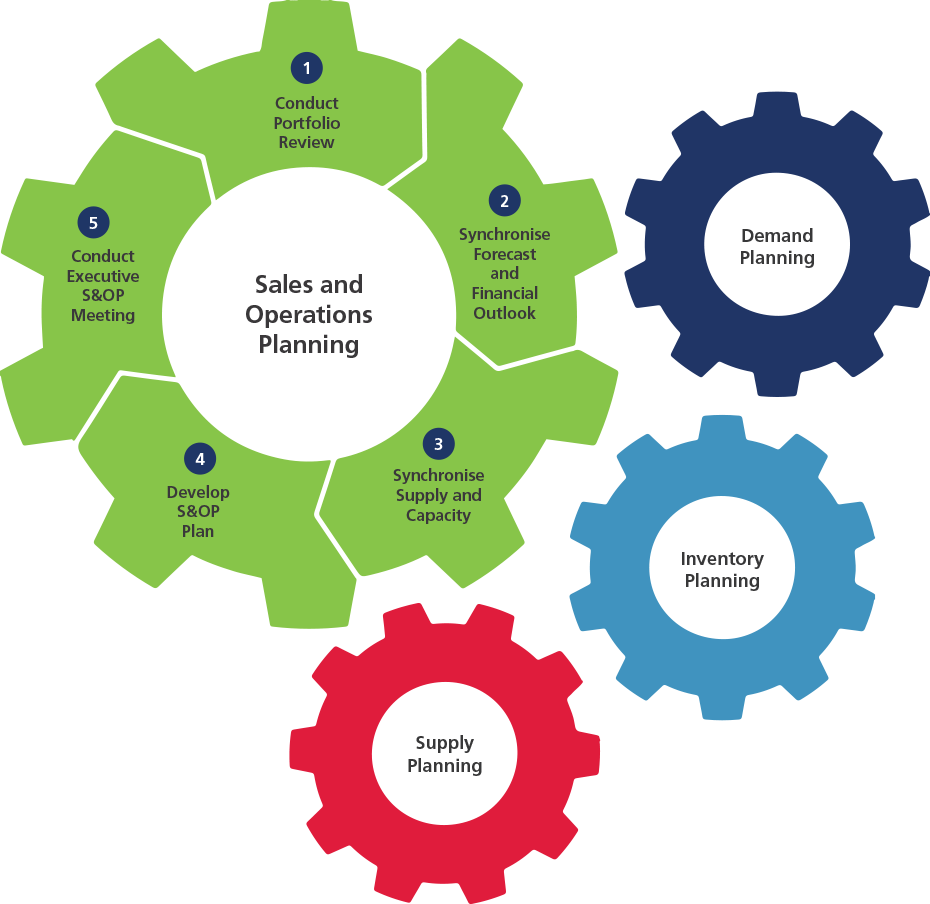By Karin Bursa
The biggest obstacles to S&OP excellence stem from the complexity of managing the process which requires amongst other things, identifying, gathering and analysing relevant data, effectively managing participants and information. Here Karin Bursa of Logility outlines a five-step road map to organising the tasks and analyses needed to S&OP excellence.
A great Sales and Operations Planning (S&OP) process maps out a realistic and profitable overall direction for your company, bringing together sales, marketing, inventory, procurement, manufacturing, and finance to decide how to best manage resources, profitably satisfy customer demand, and pursue strategic initiatives involving new markets, new product introductions, acquisitions, and more.
Traditionally, S&OP’s primary objective has been to create a feasible plan that could be executed. Today the sales and operations planning process is a means to execute corporate strategy: a process that aligns the organisation strategically to execute tactically.
Often the biggest obstacles to S&OP excellence stem from complexity — it’s too difficult to gather data, there are too many meetings, the process is too hard to govern, or key data is too difficult to analyse and report on. Leading supply chain teams have discovered that true S&OP success flows from practical thinking guided by three principles: make it easy to implement, make it easy to execute, and make it easy to sustain.
Understanding the S&OP Journey
No matter where an organisation starts, this journey is well worth the effort. A successful S&OP initiative can improve revenue by 2% – 5%, reduce inventory 7% – 15% and improve new product launch commercialisation by 20%.
The journey towards S&OP excellence starts by realising outstanding results do not appear overnight: they require time and persistence. At the start of the journey there are several potential obstacles including limited technology enablers, lack of governance, rigid functional silos, lack of shared performance measures, and ingrained company cultures.
For many companies, S&OP has been a part of the culture for a while but has not been able to gain the traction initially envisioned. If this sounds familiar take an objective look at the process, evaluate your maturity level and match your level of accomplishment against the proficiency profiles of Developing, Performing and Leading. Once you know where you stand, the road-ahead will be a lot less bumpy.
The following five-step road map provides a field-tested approach to organising the tasks and analyses needed to supply S&OP participants with the information they need to make tough decisions — decisions that will ultimately determine how well the company performs.
Step 1: Conduct Portfolio Review
With product lifecycles shortening and customer-specific requirements increasing, the ability to plan for a more dynamic product portfolio is critical. Introducing new products is challenging because the lack of historical sales data often makes statistical forecasting inadequate. Often marketing dollars have already been allocated to the product, making stock-outs an expensive proposition. If sales fall short of expectation the company is left saddled with excess and obsolete inventory.
The impact on sales, production, inventory, and finance must be understood. Give portfolio review prominence in the S&OP process, as often the success of S&OP hinges on its effectiveness. Employ advanced techniques such as attribute-based planning, which allows a company to accurately forecast new products even when no direct prior sales history exists. Conduct this review on a regular schedule to examine current product plans, new product introductions (NPI) and product retirements.
Step 2: Sychronise Forecast & Financial Outlook
The baseline statistical forecast is a good starting point, but must be augmented with insights from sales, marketing and customer service personnel. Agreement on a consensus forecast that combines the sales plan, the marketing plan, and the customer plan, while taking into account any differences with the company’s overall financial objectives enables higher forecast accuracy.
While it is important to understand the differences between the operational forecast and the financial forecast, a common pitfall is to constrain the operational plan to the financial plan. This ultimately leads to biased and inaccurate forecasting. Best practices underscore that a demand plan should be unconstrained to understand true market demand. Leverage multiple demand signals, such as Point of Sale (POS), that assist in sensing changes in demand patterns. Early detection of differences and trends will help avoid shortages or over-production and can be used to adjust the forecast to bring it closer to actual demand.
Step 3: Sychronise Supply & Capacity
The ability to analyse different supply alternatives is crucial to satisfy demand plans and to explore the impact of various factors on inventory investments, revenue, profit, capacity utilisation, and service levels. By developing time phased inventory, production, and distribution alternatives to meet demand scenarios, including the financial implications (both top and bottom-line), you can become proactive in your ability to respond to changes.
Focus on medium to long-term supply plans (3 – 18 months) at an aggregate level, rather than on granular issues faced in the short term. While it’s tempting to leverage the assembled group of decision makers to address immediate challenges, it is preferable to handle them through tactical planning and execution processes that have shorter (weekly, or even daily) planning cycles.
It is important to review alternative supply scenarios, confirming that critical parts and resources can be made available to support the different options. Given the ever-increasing complexity of production and distribution networks, alternative scenarios can best be reviewed through simulations and evaluated on metrics such as customer service, inventory levels, asset utilisation, and production and logistics costs.
Step 4: Develop S&OP Plan
While the demand and supply teams have kept the company’s overall objectives in mind, it can be common for both optimistic and pessimistic biases to creep in. Bringing teams together in this step removes bias, sychronises planning horizons, and aligns operational activities with corporate objectives. This step enhances collaboration within organisations that tend to operate in functional silos. It is important during this step to balance key metrics against company financial objectives.
Shared metrics can boost S&OP effectiveness and help the S&OP team work together to move the company toward its strategic goals and objectives. Companies that focus on a small manageable set of shared metrics at an appropriate level of aggregation have greater success. Examples of shared metrics include forecast accuracy at the product family level for a 90 day horizon, inventory turns, customer service levels, and profitability.
A common pitfall here is to focus only on the supply side while ignoring the demand side. Among the many options for resolving demand and supply imbalances are demand levers such as controlling the timing of promotions.
Step 5: Conduct Executive S&OP Meeting
Executive engagement in the meeting is critical to drive adoption and execution of the plan, increasing the probability for long-term success and value.
Projecting plans onto a screen from the planning system, rather than using handouts, is one effective method for keeping everyone engaged. Plans should be presented at an appropriate level of aggregation with the option to drill down into more detail as needed. Having information readily available, with the ability to analyse it in real-time, creates informed decisions, as opposed to “shooting from the hip” based on out-of-date information printed on a handout.
Conclusion
Successful Sales and Operations Planning is a journey of continuous improvement that aligns an organisation strategically to execute tactically. Smart companies evaluate where they currently reside along the S&OP maturity spectrum, matching their level of accomplishment against three proficiency profiles (Developing, Performing and Leading). This encourages organisational awareness of the overall journey toward strategic best practices that lies ahead.
In the end, a practical approach to achieving S&OP excellence must be guided by three principles:
1. make it easy to implement
2. make it easy to execute, and
3. make it easy to sustain.
Keeping these imperatives in mind, move along the five-step process outlined above to reach unbiased, fact-based collaborative decisions. With these elements in place, companies of all sizes across all industries can achieve the game-changing profitability and competitive advantage that outstanding Sales and Operations Planning makes possible.
About the Author
 Karin L. Bursa is a vice president at Logility, a provider of collaborative supply chain management solutions. Ms. Bursa has more than 25 years of experience in the development, support and marketing of software solutions to improve and automate enterprise-wide operations. You can follow her industry insights at www.logility.com/blog. For more information, please visit www.logility.com.
Karin L. Bursa is a vice president at Logility, a provider of collaborative supply chain management solutions. Ms. Bursa has more than 25 years of experience in the development, support and marketing of software solutions to improve and automate enterprise-wide operations. You can follow her industry insights at www.logility.com/blog. For more information, please visit www.logility.com.



































